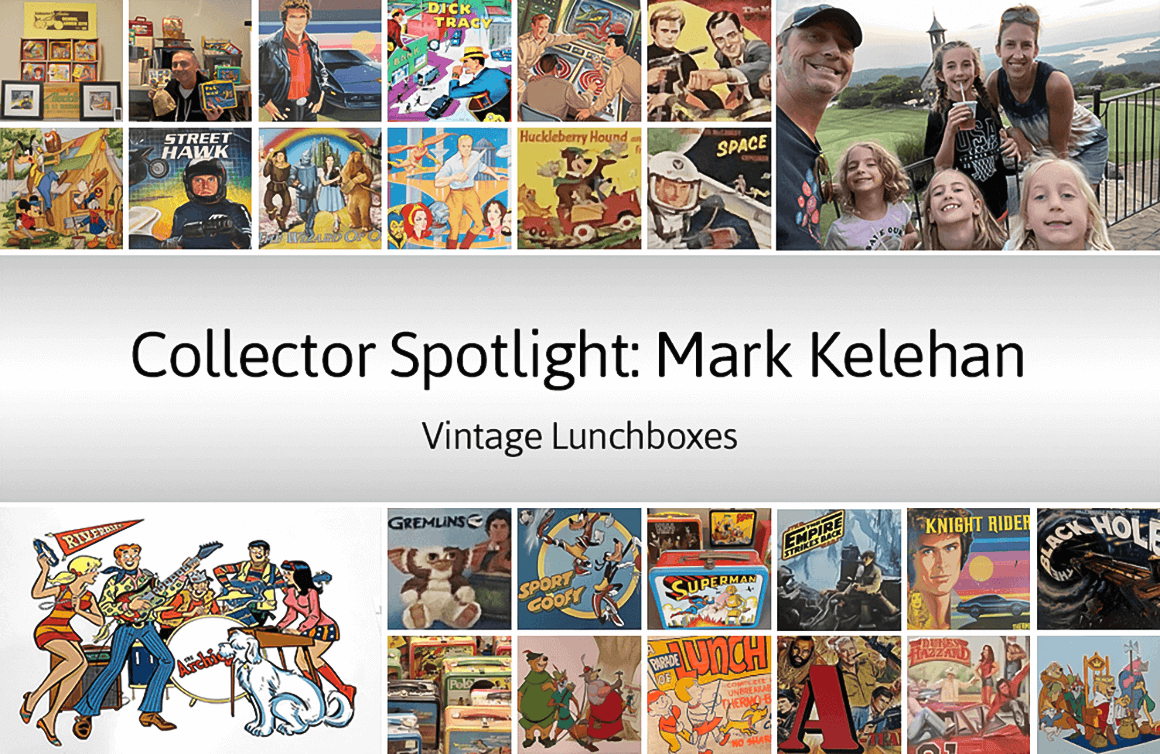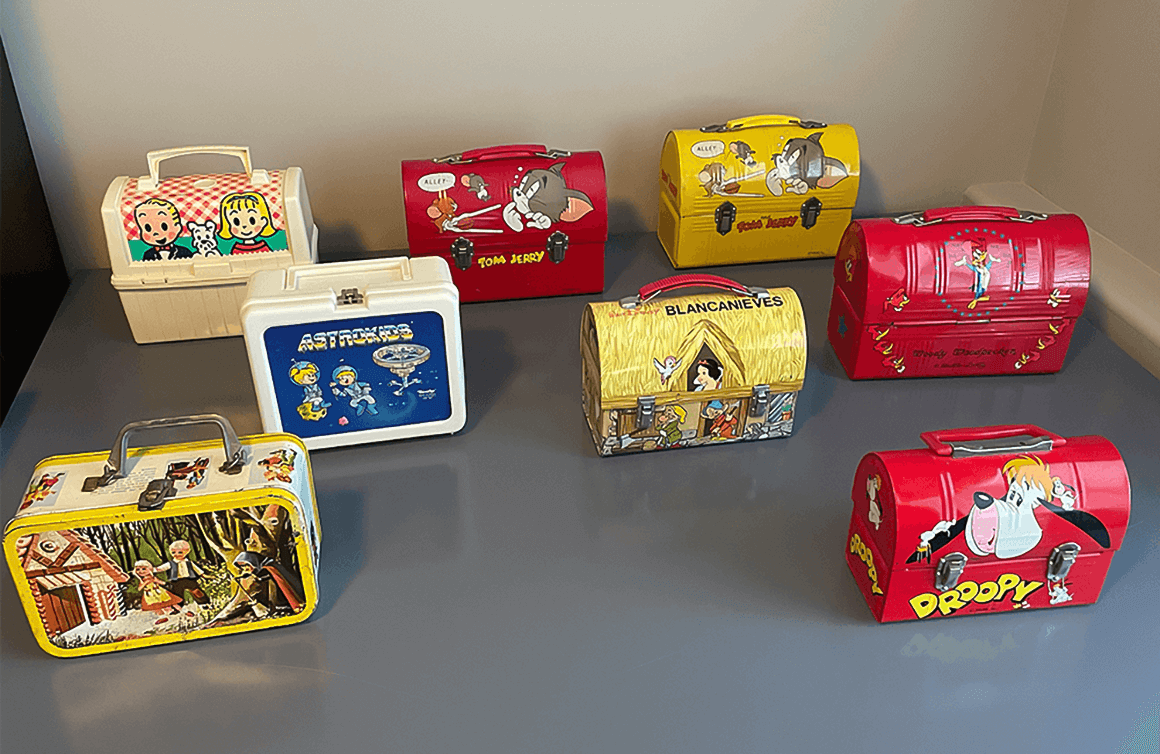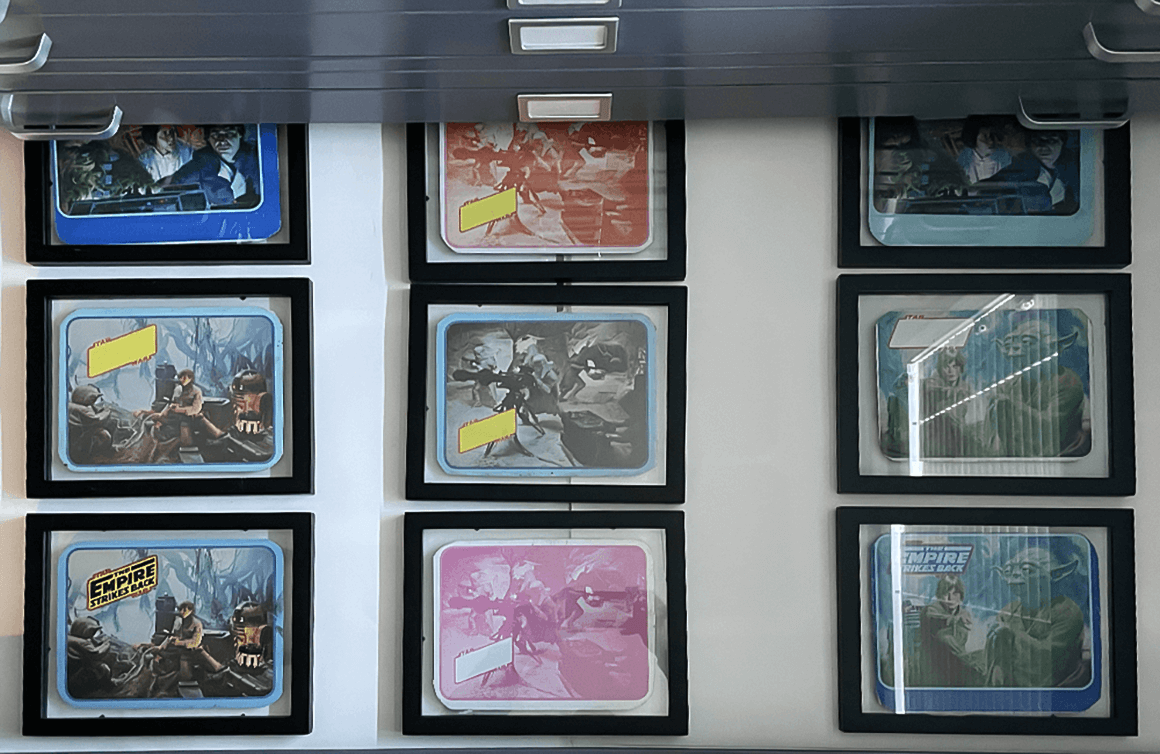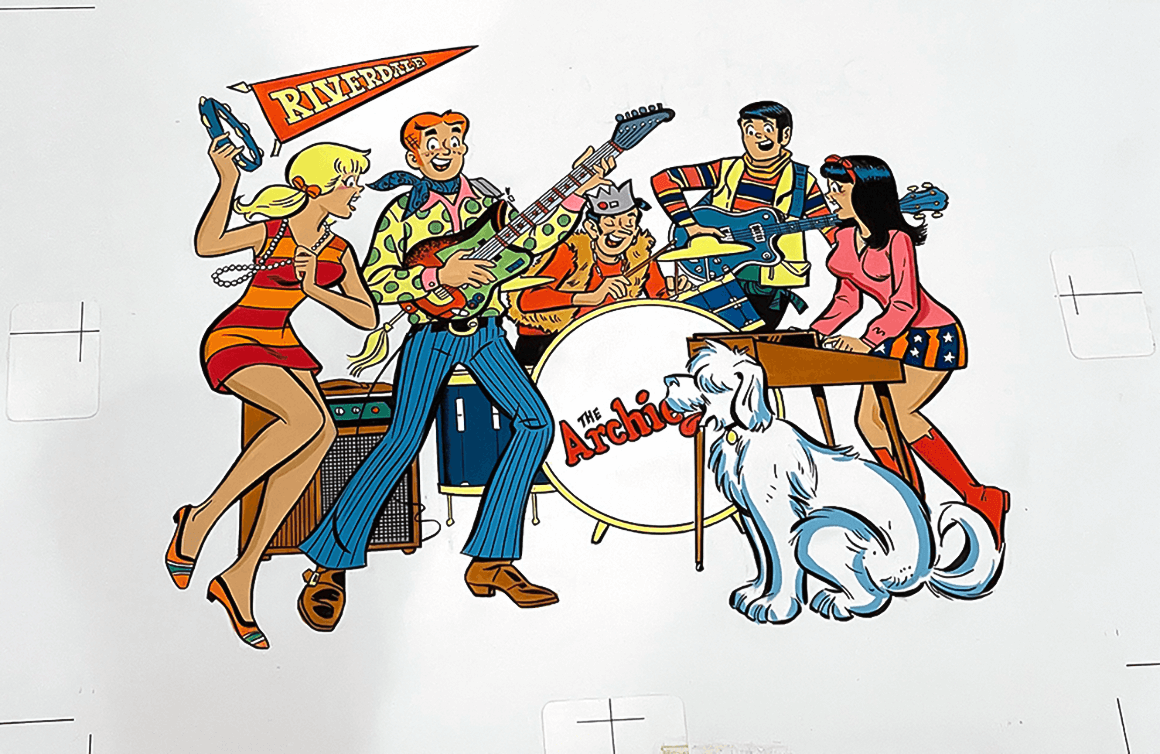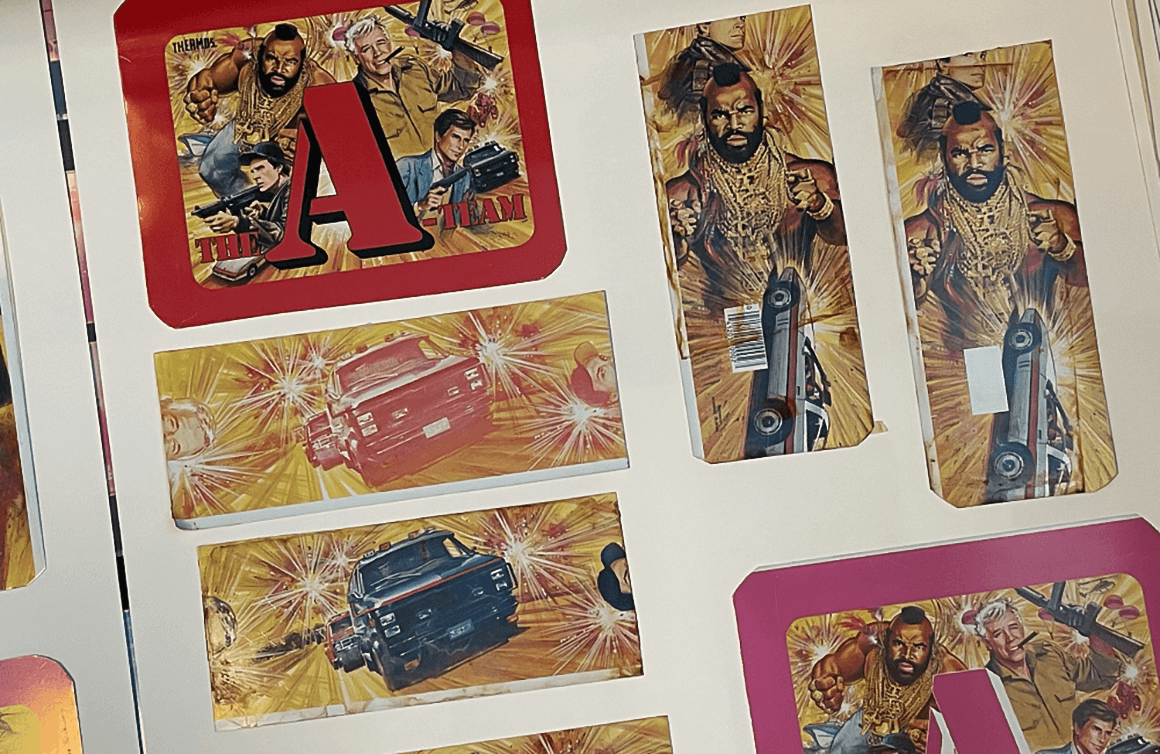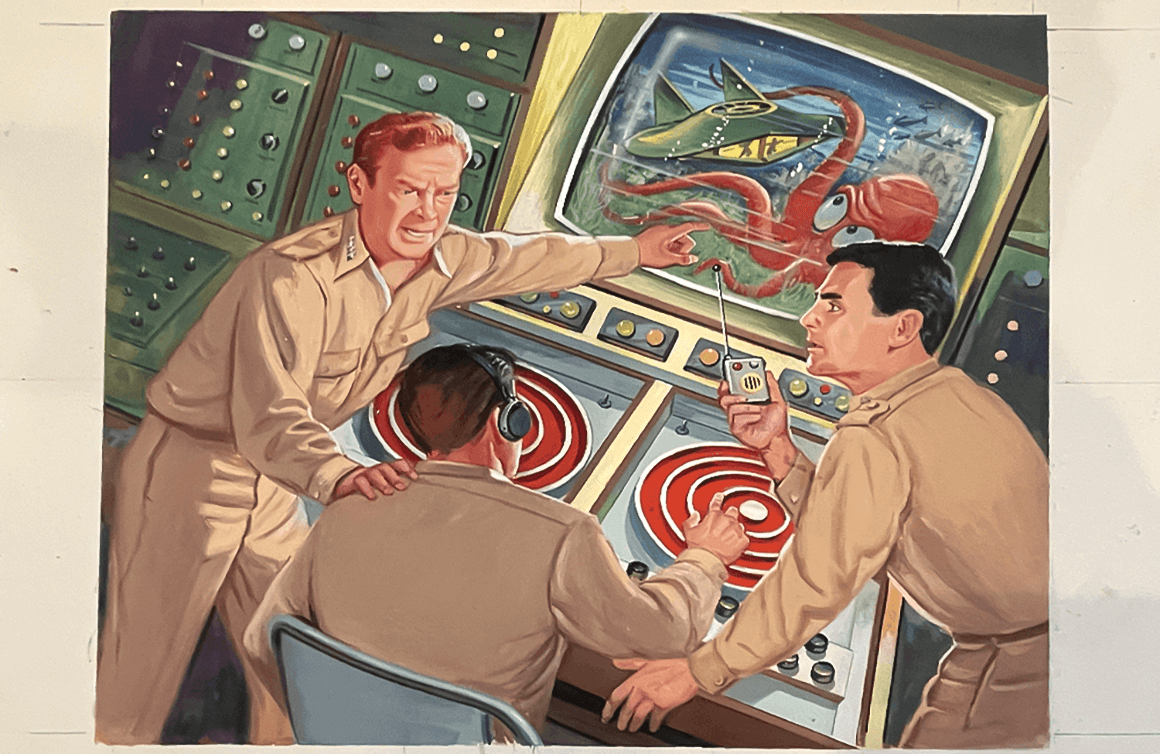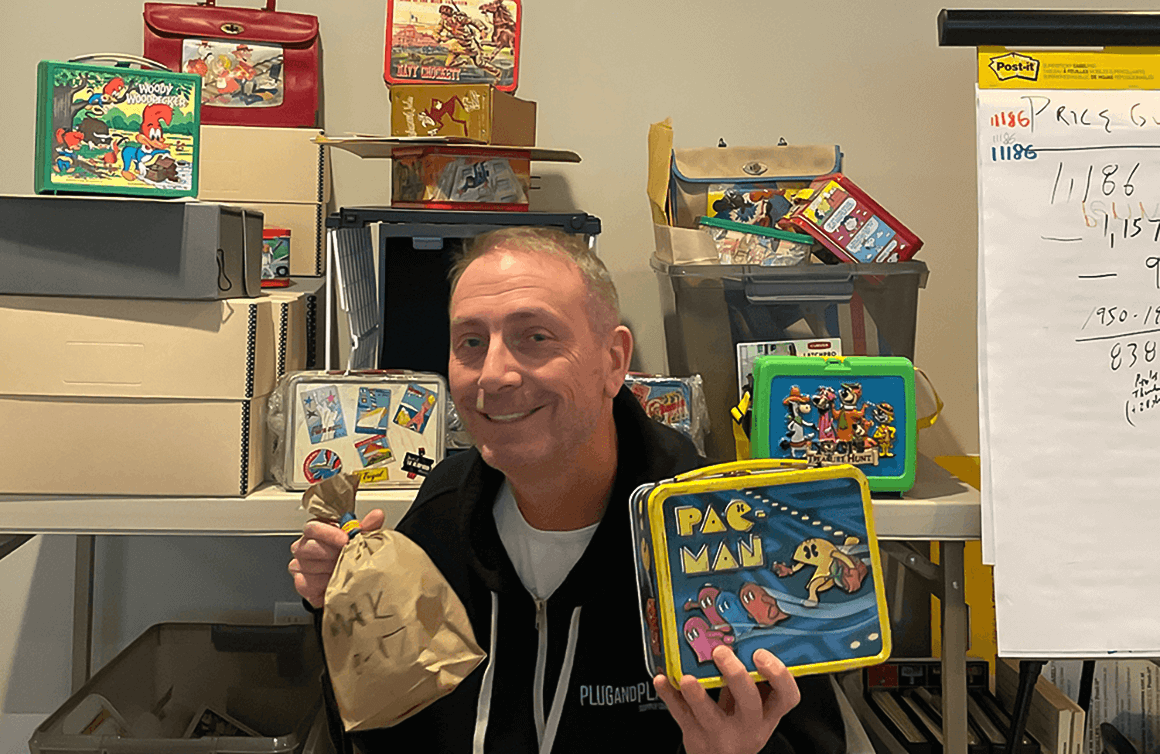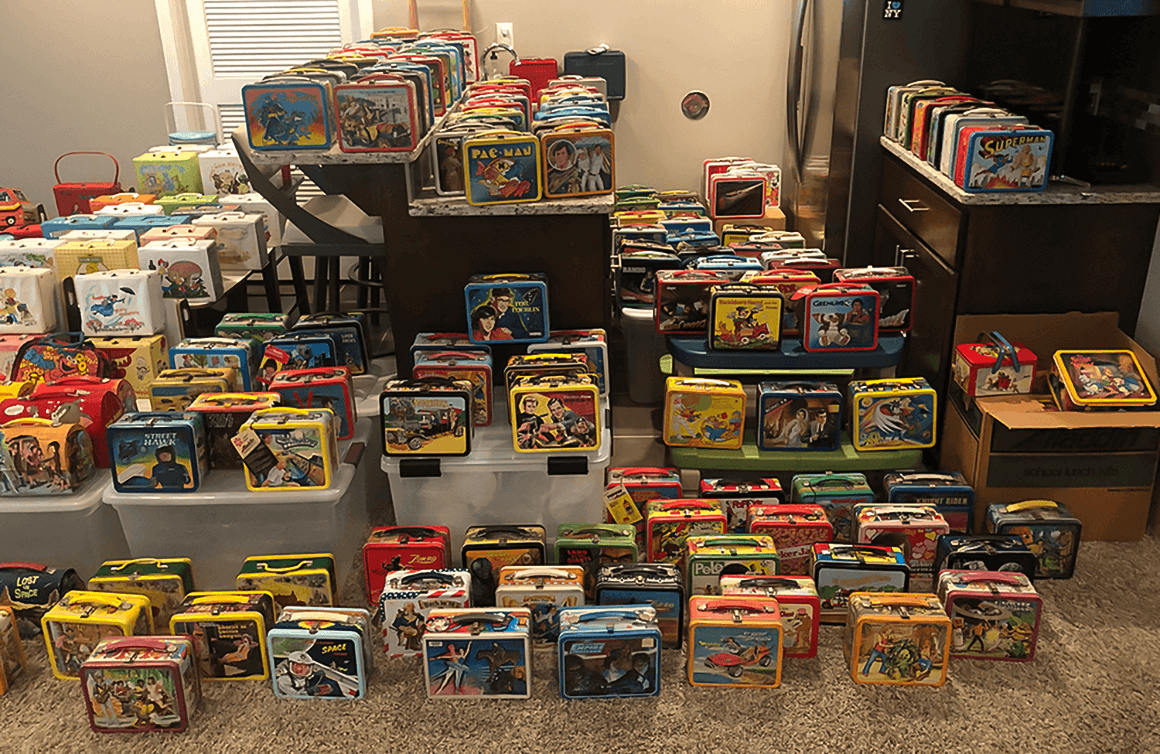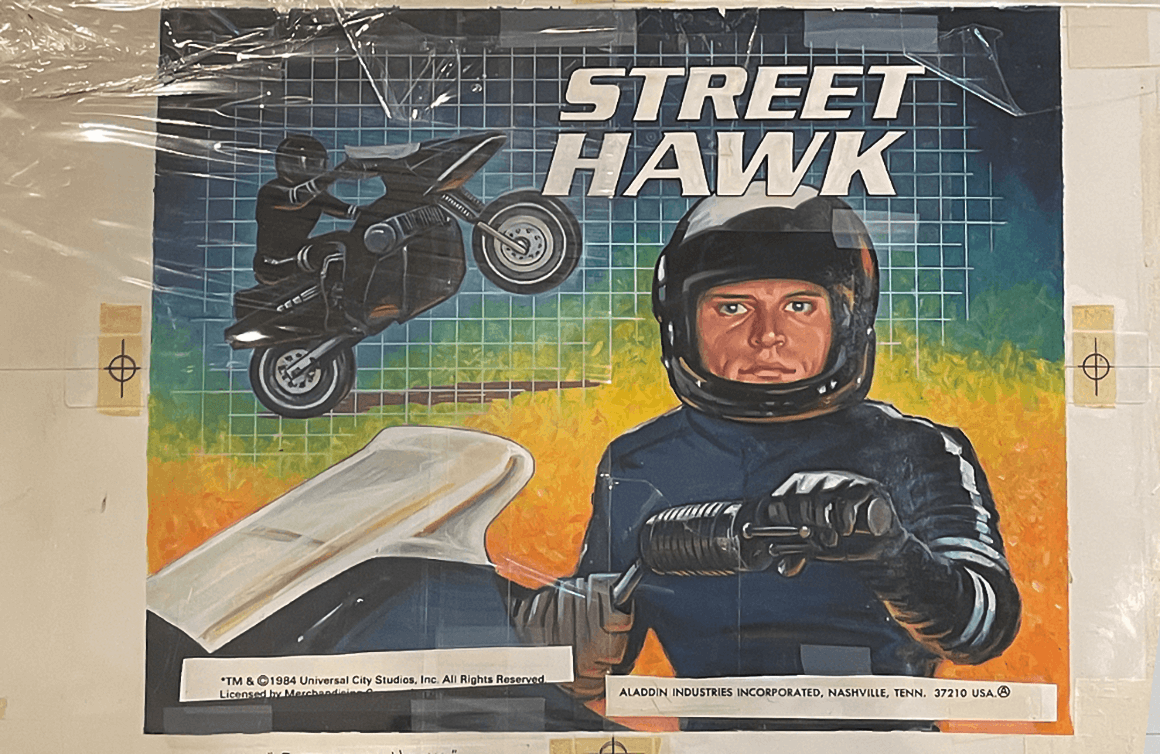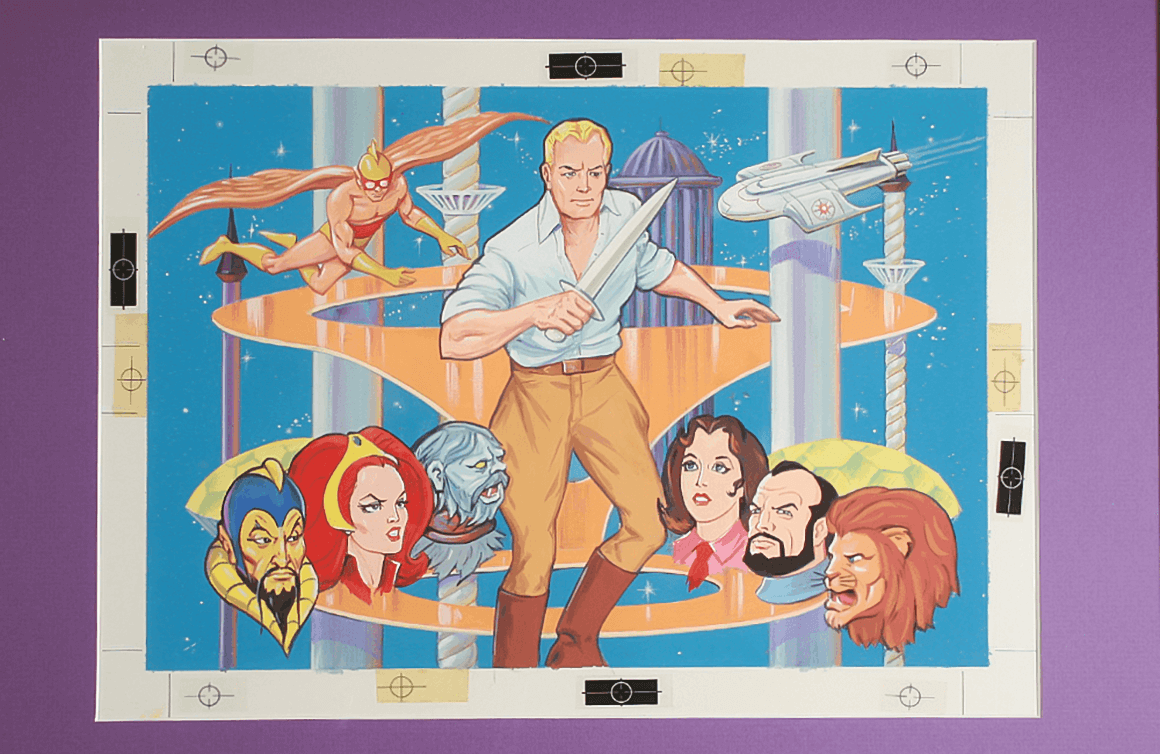How do you describe your collection?
I describe my collection as a unique celebration of the lunchbox!
The core of the collection consists of over 800 lunchboxes, primarily vintage metal and plastic lunchboxes made during the Golden Age of lunchboxes between 1950 and 1985. But what I find even more exciting in my collection are the unique, original lunchbox-related artifacts like original, one-of-a-kind paintings, production and proof sheets, sales brochures, and original displays. The paintings and production items are so unique, colourful, and rare that I enjoy hunting for and buying these pieces. It has become somewhat easy to locate the original lunchboxes on online platforms such as eBay and Facebook. The other items are more of a challenge, which is something I enjoy.
Between the lunchboxes, the related artifacts, and all the research I have conducted at various institutions as well as interviews with former employees of lunchbox manufacturers, I really have come to learn and appreciate the rich history of lunchboxes. They tell the story of pop culture in the United States.
When it comes to some of my unique pieces, I have old tobacco tins and cookie jars from the 1880s and early 1900s that were used as the first form of lunchboxes by kids who wanted to mirror what their parents were doing as they went off to work away from home.
I have the first Thermos bottle made in the United States by the Thermos company in Brooklyn, New York, in 1907. I also have the first school lunch kit that was made — it’s from 1914. It’s cool because most of the common literature cites the first school lunch kit being produced in 1920. In talking with experts and researching the Thermos archives, I was able to find advertisements that clearly demonstrate the origins of that item and provide legitimate support for its provenance. It was that research that got me on the hunt to find the item. I ended up buying the item from a friend who is an avid Thermos collector and whose father worked at the company. That’s probably my oldest school lunch kit because it’s the actual first lunch kit marketed for school usage. On a side note, the advertisements for the kit include its cost — $3.50. That was a lot of money 100 years ago. It would be over $100 today. I believe this establishes the first school lunch kit as a luxury item that very few people could afford. The Thermos school lunch kit was a leather case with metal dividers inside and a leather handle. It was very posh.
Fast forward to 1985, the prices of character lunchboxes were about $5 but by that time they were mass produced and had become more commonplace – insert lesson on economics here.
The first licensed character lunchbox was a Mickey Mouse lunch tin made in 1935. It wasn’t made by one of the main manufacturers, Aladdin Industries or Thermos. It was more of a one-off that was not mass produced. It wasn’t until 15 years later that the widely accepted licensed character lunchbox was made when Aladdin Industries placed a Hopalong Cassidy decal on a red lunchbox. They had tremendous sales in the first year and, as a result, licensed and unlicensed lunchboxes blossomed over the next 35 years.
When and why did you start your collection?
I have always liked collecting and organizing items like sports cards, toys, and lunchboxes. That passion for collecting came primarily from my mom who enjoyed collecting all sorts of things. Collecting runs in my family and my brothers also collect various items.
I actually never carried a character lunchbox to school. I grew up overseas because my father was in the army and spent my childhood — from kindergarten until I graduated high school — on military bases in Germany. I mostly went home for lunch or carried a brown bag lunch, as many people did.
After high school, I moved to Omaha — where most of my relatives lived — to attend college in 1993. In 1994, I went to a flea market in Omaha and saw a 1980 Pac-Man lunchbox and thought it was super cool. The Pac-Man lunchbox was in okay shape and cost $15. It was a little beat up but looked cool. It reminded me of a lot of things from my childhood. After I bought that lunchbox, I was curious to know what other lunchboxes were made, so I went to Barnes & Noble to buy a toy magazine and found a price guide produced for lunchboxes. When I saw how many lunchboxes were actually produced, it blew my mind and kickstarted my interest in buying more. I would go to flea markets, antique malls, garage sales, and things of that nature and just bought basically whatever I could that was within my geographic reach — this was just before eBay was a mature online platform.
When eBay arrived, it became much easier to find lunchboxes and a little more transactional. I still enjoyed hunting for boxes at flea markets but started to find fewer “in the wild”. During my time in New York, I started going to toy shows and meeting collectors who had other things like production art and production plates. That started me on this journey to go deeper than just the lunchboxes. The other things were more challenging and exciting, like finding former employees who had the artwork or finding collectors who bought prototype lunchboxes that were rare one-off things. I love hunting down this kind of stuff. It helped me better understand the companies and the history of lunchboxes. It’s exciting to hunt these things down and meet new people along the way by cold-calling or messaging them on Facebook.
Eight out of 10 people are great and welcome the conversation. I’ve met people with large collections, former illustrators from Aladdin who created this wonderful artwork, and former employees who worked in research and development. That’s really how this collection has evolved into a diverse collection of lunchbox artifacts along with interesting stories from the key players who helped lunchboxes become so popular not only as food carriers but also as collectibles.
With that said, when looking at my collection and the associated stories, I scratched my head at what exactly to do with all that content. I really want to be able to tell these stories and have other people appreciate them along with the rare pieces I accumulated. None of this has been overly public, but I want to put the story out there as much as possible and have people learn about this history. It speaks a lot not only to people’s childhoods but also to the evolution of pop culture and American industry over four decades. So, I made a pitch to a local museum — The Durham Museum — and they accepted it. Now I’m preparing to exhibit my collection which is very exciting and fun for me. I’m learning so much about museum exhibit preparation and the folks at the Durham have been tremendously patient and helpful. There have been several displays of lunchboxes at various museums, but never has there been an exhibit that displays all the one of kind paintings and original production artifacts which are super cool! The exhibit runs from March 4 to September 3, 2023. After that, I’d love to have the exhibit travel to other museums because I think the topic and insights are timeless and are a great reflection of history and popular culture in the United States.
How do you display and store your collection?
Before we moved houses, the primary domain where I was authorized by the boss of the home — Lori, my wife — to display these items was my basement office. I displayed the original lunchbox paintings on the wall right next to the lunchbox, and also had some of the more unique pieces like display headers, posters, and special lunchboxes on display.
In our new home, I haven’t mustered the energy to set that up again because taking it all down was quite the chore! I do, however, have two lunchboxes out — the Pac-Man lunchbox that I mentioned earlier and my mom’s Roy Rogers lunchbox. I have 70 large storage bins filled with lunchboxes in my utility room because I had to go through the collection to inventory it and label everything to prepare them for inclusion in the exhibit.
For the original paintings and artwork, I spent some time at the Smithsonian to learn how they store their collection. I bought archival-type materials and a couple of large industrial flat filing cabinets to store all my artwork and things of that nature.
With this upcoming exhibit, I’ve been trying to keep inventory a bit better and finally have pictures of everything. I’ve started to put those 7500 pictures into categories and organize them so at least I have a visual inventory, but there is more work to be done.
What do you consider to be the Holy Grail of your collection?
From the lunchbox standpoint, one of my Holy Grails is the 1954 Superman lunchbox in near-mint condition. It is the first Superman lunchbox which was made by a company called Adco and is relatively rare to have in great condition. In April 2021, a mint condition 1954 Superman sold for about $18,000!
Although it is tough to narrow it down to one piece, I believe all the original lunchbox artwork is very special. Most of the lunchboxes manufactured during the Golden Age started out with concept drawings and then progressed to a final hand-painted art that was 1.5x the size of the lunchbox. Generally, there was one piece for the front, one for the back, and one for the side of the lunchbox. Each of these was largely handmade by illustrators who worked for the manufacturers. The paintings are detailed, colourful, and one-of-a-kind masterpieces. This makes them quite rare. Most of the original artwork is said to have been discarded or destroyed after production which makes the remaining pieces in existence even rarer and more desirable in my view. By my estimates, I have the largest single collection of original lunchbox artwork in private collector hands. The largest collection resides in the archives at the Smithsonian, which I offered to buy but they respectfully declined.
If I had to choose a subset of these paintings to classify as Holy Grails, I would call out my three pieces — front, back, and sideband — from the Knight Rider lunchbox that was produced by Thermos. It’s rare to have all three pieces from a Thermos lunchbox because, by some accounts, 90 percent of the artwork at Thermos was destroyed. For that reason, the majority of the artwork in my collection is from Aladdin Industries, but the five or six pieces of Thermos artwork — such as those three Knight Rider pieces, the back of the G.I. Joe lunchbox, and a few others — are super cool.
I would also place lunchbox prototypes on my Holy Grail list. I have several, but one that is particularly cool and has a nice backstory is the rare plastic Aladdin lunchbox called Project Shuttle. What I like about this is not really the imagery but the fact that I had acquired the original artwork for this lunchbox nearly 10 years ago. I knew the lunchbox existed because I saw it in sales literature. I was determined to hunt it down. I set up eBay alerts, Google alerts and would check eBay often to try to locate this elusive Project Shuttle lunchbox. Nothing ever turned up. I had given up hope but then, about four months ago, as luck would have it, someone posted an image of this lunchbox on a Facebook lunchbox page. I quickly hopped on the opportunity to acquire this and reunite it with the original painting. I was extremely excited because it was such a focussed, targeted search for nearly a decade and it finally, and improbably, showed up!
There are a couple of lunchbox prototypes that I’d like to acquire. One is from a show called The Man from Atlantis. There were only two or three prototypes made. They pop up periodically in the $20,000 to $30,000 range. As much as that has eluded me, I’m not sure it has that much value to me yet, but it would be nice to add to the collection. I have also been trying to hunt something down the prototype of the original Hopalong Cassidy lunchbox from 1950. I’ve seen it in a book and have tried to track it down. That’s the biggest missing Holy Grail for me.
What advice would you give to someone interested in starting a vintage lunchbox collection?
In my opinion, collecting anything, including vintage lunchboxes, should first and foremost be fun.
I think starting small and having a focus is a good start. Maybe you enjoy the sci-fi or Western genres. You could start with that. Or maybe your focus is on collecting a specific type of lunchbox, like vinyl or metal domes. Having a focus and staying within your means are key pieces of advice. It’s easy to get carried away and then lose focus.
If you can have fun and accomplish what you set out to do, you will get a great sense of self-satisfaction and accomplishment. Of course, once you accomplish your initial goal, you can display them for you and others to enjoy and call it a day. Or, if you’re like me, you set new goals and then progress towards those. Honestly, that statement applies not just to collecting, but to almost anything you want to accomplish in your life. Set aspirational goals, work hard with integrity to achieve them, don’t give up, and — most importantly — have fun!
Visit The Durham Museum’s website to learn more about Mark’s upcoming exhibit, The Lunchbox: Packed with Pop Culture.
Drop us a line to let us know about your collection of vintage toys and/or games. We just may feature your collection!

